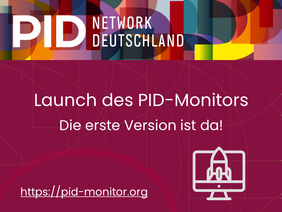Discover the first version of the PID Monitor. It provides valuable insights into the distribution and evolution of different types of persistent identifiers (PIDs).
We are pleased to announce the release of the first version of the PID Monitor! The platform is now available under the independent domain PID-Monitor.org. This application is being developed as part of the DFG-funded project ‘PID-Network Deutschland’ with the aim of visualising the continuous monitoring of the distribution of different PID types in publication, information, and research infrastructures as well as the linking of PIDs over time.
PIDs are essential in cultural and scientific institutions to ensure a stable and smooth process in the management, accessibility and long-term preservation of resources. They play a crucial role in the digital transformation of science and research by uniquely identifying resources and ensuring their discoverability and long-term accessibility. They are also used to link different knowledge and research resources together. This can be done at local, national, international and discipline-specific levels.
We are pleased to announce the release of the first version of the PID Monitor! The platform is now available under the independent domain PID-Monitor.org. This application is being developed as part of the DFG-funded project ‘PID-Network Deutschland’ with the aim of visualising the continuous monitoring of the distribution of different PID types in publication, information, and research infrastructures as well as the linking of PIDs over time.
PIDs are essential in cultural and scientific institutions to ensure a stable and smooth process in the management, accessibility and long-term preservation of resources. They play a crucial role in the digital transformation of science and research by uniquely identifying resources and ensuring their discoverability and long-term accessibility. They are also used to link different knowledge and research resources together. This can be done at local, national, international and discipline-specific levels.








